BOURSE SECURITIES LIMITED
9th March, 2020
PHL Improves, COVID-19 Persists
This week, we at Bourse review the performance of Prestige Holdings Limited (PHL) for its financial year ended 30th November, 2019. PHL would have delivered an improved performance to shareholders on account of increasing revenues and sound cost management.
Internationally, financial markets continued to react to developments related to the Novel Coronavirus (COVID-19). Global policymakers made significant decisions in response to COVID-19 in the past week, which were met by mixed reactions from investors. We discuss below.
Prestige Holdings Limited (PHL)
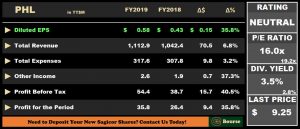
Prestige Holdings Limited (PHL) reported Diluted Earnings Per Share (EPS) of TT$0.58 for the financial year ended 30th November, 2019, a 35.8% improvement from TT$0.43 in 2018.
Total Revenue climbed to TT$1.1B, up 6.8% Year on Year (YoY). This was accompanied by a 3.2% increase in Total Expenses from TT$307.8M to TT$317.6M. The Group generated Other Income of TT$2.6M for FY 2019, exceeding the prior year by 37.3%. Profit Before Tax amounted to TT$54.4M, up 40.5% from TT$38.7M. The Taxation charge moved up from TT$12.3M to TT$18.5M, giving an overall Profit for the Period of TT$35.8M, 35.8% higher YoY.
Outlook
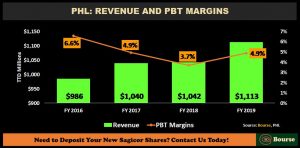
At the end of its 2019 financial year, PHL was able to record top line growth of 6.8%, a recovery from its 2018 performance which was influenced by adverse domestic economic conditions. Over the course of 2019, PHL was able to open new restaurants and remodelled and relocated others, expanding its market penetration. The Group was also able to report an improvement to its Profit Before Tax Margin, moving from 3.7% in 2018 to 4.9% in 2019.

PHL was able to maintain its Gross Profit Margin at 33.6% for FY 2019, relatively unchanged from that recorded in FY 2018 at 33.5%. The Group improved its Operating Profit Margin in 2019, at year end reporting a 5.3% Margin, exceeding the 4.2% achieved in 2018. Going forward, PHL has underpinned its commitment to improve operations and contain costs. At the end of FY 2019, PHL was able to slightly improve its Net Profit Margin at 3.2%, up from that recorded at the end of the last financial year (2.5%).
The Bourse View
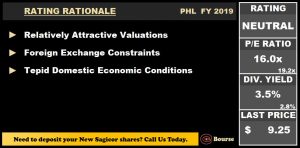
At a current price of TT$9.25, PHL trades at a trailing Price to Earnings ratio of 16.0 times, below the Trading sector average of 19.2 times. The stock also offers investors a trailing dividend yield of 3.5%, above the sector’s average of 2.8%. On the basis of relatively attractive valuations, but tempered by foreign exchange constraints and less than favourable domestic economic conditions, Bourse maintains a NEUTRAL on PHL.
COVID-19 Concerns Continue
There was no respite for international investors this week, as concerns of the economic impact of the Novel Coronavirus (COVID-19) continue to spread across the globe. Thus far, the virus has spread to 96 countries and territories around the world while the number of reported cases now exceeds 100,000. The recovery rate of the virus currently stands at approximately 55%, while its fatality rate is estimated to be in the region of 3%.
In response to the potential health and economic impact of COVID-19, several governments and organizations have taken emergency decisions to support economic activity and promote investor confidence. Based on initial reactions by financial markets however, these initiatives appear to have had little to no impact.
US Federal Reserve Cuts Rates
In an emergency meeting held on the 3rd of March, the decision was made by the Federal Open Market Committee (FOMC) to cut its benchmark interest rate by 50 basis points. The decision came amid concerns surrounding the potential economic toll of the coronavirus and the ongoing impact on the US stock market, which faced a week on week correction on the 28th of February. Financial markets appeared to view this as negative, confirming their fears about COVID-19, with US markets dropping 2.8% at Tuesday’s close.
US Markets Endure Volatile Week
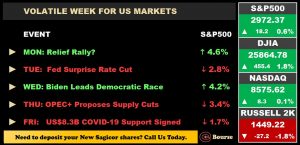
It was a rollercoaster week for US and broader global markets, with wild price swings brought about from COVID-19 and policymakers’ responses.
On Monday, the US market experienced what appeared to be a relief rally, rebounding from a seven-day losing streak as the S&P 500 advanced 4.6% with investors snapping up what seemed to be ‘bargain’ prices.
Tuesday’s US Federal Reserve’s issuance of an emergency rate cut of 50 basis points (from 1.75% to 1.25%) was not well received, seemingly confirming investors’ fears about the widespread impact of the Coronavirus. The S&P 500 fell 2.8%
US markets surprisingly recovered on Wednesday with the S&P 500 advancing 4.2%, following news that Joe Biden was emerging as the prime candidate within the democratic party, getting a delegate total of 453, ahead of Bernie Sanders’ total of 373.
Elevated concerns of a slump in global energy prices prompted OPEC’s announcement on Thursday that they would be discussing an additional 1.5 million barrels per day (bpd) cut until the end of the year in order to offset the negative effects of the coronavirus; this decision however was said to be dependent on Russia’s approval as part of the so-called ‘OPEC+’ grouping. The S&P 500 subsequently closed 3.4% lower.
On Friday, it was reported that Russia did not agree to OPEC’s suggested cut in supply, the organization’s further decision will be monitored from here. The COVID-19 virus continued to plague markets as the number of reported cases worldwide surpassed 100,000. In an effort to ensure that US markets are properly prepared for the worsening virus outbreak, President Trump signed a US$8.3B emergency coronavirus spending package on Friday. The S&P 500 closed the week on a negative note, down 1.7%.
Energy Stocks Continue to Fall
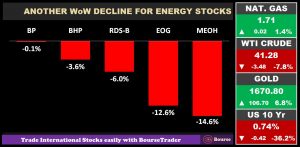
Energy stocks continued to head lower as energy prices remained weak. Methanex Corporation (MEOH) recorded the largest loss week on week (WoW) of 14.6%. Meanwhile, BP Plc (BP), BHP Group (BHP), Royal Dutch Shell (RDS-B) and EOG Resources Inc. (EOG) shed 0.1%, 3.6%, 6.0%, and 12.6% respectively WoW.
Flight to Safety
Investors continue to flee to safe haven assets, driving US Treasury yields to record lows. The 10-year US Treasury yield fell below 1% for the first time, reaching 0.74% losing 0.42% w-o-w. Meanwhile, the 2-year, 5-year and 30-year US Treasury yields slid to new lows at 0.46%, 0.55% and 1.32% from 0.91%, 0.94% and 1.69% respectively one week ago. As investors’ fears surrounding the rapid spread of the COVID-19 continue to rise, yields are expected to remain pressured.
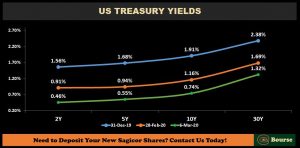
Investor Considerations
The situation remains quite dynamic for investors, as COVID-19 rattles economic prospects and investor sentiment. We reiterate our investor positioning from last week, based on your personal ability/willingness to tolerate risk:
For the Conservative or Low Risk investor, the current market volatility is usually best avoided. This may be as simple as doing nothing, if you are already on the investing ‘sidelines’ or if you are invested in instruments such as money market mutual funds, repurchase agreements or other low risk solutions. For the low risk investor with some exposure to international equity markets, the prudent approach might be exiting the market for now.
For the Moderate or Medium Risk investor, the best course of action might be to ride through the volatility. It is still fairly early to determine the severity and length of the impact that COVID-19 could have on the global economy and financial markets. Accordingly, the Moderate investor might be minded to avoid cutting losses, but at the same time not want to risk adding additional exposure to international equity at this time.
For the Aggressive or Higher Risk investor, the recent sharp market correction could be viewed as an opportunity to add stocks to your portfolio. Many blue-chip companies have experienced double-digit declines in the past week, putting them at fairly attractive levels. While it is not clear whether the market has ‘bottomed out’ with the latest correction, the higher-risk tolerant investor may be inclined to begin acquiring stocks which have undeservedly taken a beating in the latest market meltdown.
As always, it makes good sense to consult with an expert investment adviser such as Bourse to make the most informed investment decision.
For more information on these and other investment themes, please contact Bourse Securities Limited, at 226-8773 or email us at invest@boursefinancial.com.
“This document has been prepared by Bourse Securities Limited, (“Bourse”), for information purposes only. The production of this publication is not to in any way establish an offer or solicit for the subscription, purchase or sale of any of the securities stated herein to US persons or to contradict any laws of jurisdictions which would interpret our research to be an offer. Any trade in securities recommended herein is done subject to the fact that Bourse, its subsidiaries and/or affiliates have or may have specific or potential conflicts of interest in respect of the security or the issuer of the security, including those arising from (i) trading or dealing in certain securities and acting as an investment advisor; (ii) holding of securities of the issuer as beneficial owner; (iii) having benefitted, benefitting or to benefit from compensation arrangements; (iv) acting as underwriter in any distribution of securities of the issuer in the three years immediately preceding this document; or (v) having direct or indirect financial or other interest in the security or the issuer of the security. Investors are advised accordingly. Neither Bourse nor any of its subsidiaries, affiliates directors, officers, employees, representatives or agents, accepts any liability whatsoever for any direct, indirect or consequential losses arising from the use of this document or its contents or reliance on the information contained herein. Bourse does not guarantee the accuracy or completeness of the information in this document, which may have been obtained from or is based upon trade and statistical services or other third party sources. The information in this document is not intended to predict actual results and no assurances are given with respect thereto.”
